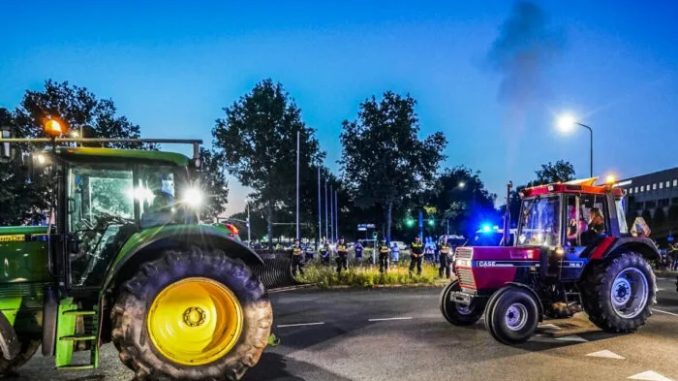
The EU has completely overplayed its hand, no support among people anymore, time to throw that totalitarian, corrupt, leftist swamp out and into the dust bin of history, just write it off as another communist, evil failure, because that is what it is!
R. J. L.
Related: Power Showers May Be Banned
By Koen Vogel – Principia Scientific International
The BBB’s success is mainly due to their opposition to the government’s plans to forcibly expropriate Dutch farmland in order to meet European Union (EU) nitrogen emissions guidelines.
Most of the public and many of the politicians – including the Eu parliamentarians who voted on this legislation as well as those who are trying to implement it in the Netherlands – are confused about what is being reduced and why it is necessary.
Many senior Dutch politicians had a “deer in the headlights” look on their faces when asked why these measures were necessary (back when the MSM still did critical interviews) and could only mumble something about ‘saving our environment’. A few (erroneously) thought it was about ‘climate change’.
The EU Guidelines Aim To Reduce “Nitrogen Emissions”.
“Nitrogen”, or N2, is an atmospheric gas and is not harmful to humans or the environment.
78 percent of our atmosphere is nitrogen.
Digging a little deeper (https://www.clo.nl/nl018327) reveals that what the EU and Dutch government term nitrogen consists of the sum of NOx (nitrous oxides), which are mainly emitted by traffic and industry, and NH3 (ammonia), which is almost entirely emitted by agriculture.
The stated aim of the EU is to reduce all “nitrogen” emissions, which in The Netherlands consists roughly of 200 kilotons of NOx and 100 kilotons of NH3. Note that these numbers have already come down from 600 and 350 kilotons resp. since 1990.
Also note that neither NOx or NH3 is a ‘greenhouse’ gas.
The NOx and NH3 emissions eventually enter the soil, either by rainfall (“wet deposition”) or via plant consumption from air (“dry deposition”). This nitrogen increase acts as a fertilizer, so plants in general grow better when atmospheric NOx and NH3 are higher.
The goal of the EU guidelines is mainly to protect the biodiversity in the EU-defined Natura-2000 areas. Studies have indicated that rare, endangered plants often prefer poor soils, so an increase in the soil “richness” might cause them to be unable to compete against other plant varieties.
Certain moss types are often cited as examples. These rare plants in turn are often consumed by rare, endangered animals. A species of frog was cited as an example. So, counterintuitively, an increase in soil richness due to an increase in NOx and NH3 may harm biodiversity.
The EU guidelines aim to reduce nitrogen emissions near Natura-2000 areas. The Netherlands is a small country, yet has over 160 Natura-2000 areas, which means you can’t exhale without being near at least one.
The guidelines were voted on by the 705 (!) member EU parliament, in which the Netherlands is allocated 29 seats. It is ironic that Dutch voter turnout for EU elections typically hovers between 30-40 percent: a majority of voters stay at home.
The Dutch government – led by the right-of-center “liberal” Mark Rutte – is therefore trying to impose a guideline that was imposed by a majority of non-Dutch EU parliamentarians, many of whom had no clue on what they were voting on or the impact it would have on the Dutch people or economy.
The Dutch government is thereby not per se doing what the Dutch voters -represented by the coalition government – have mandated them to do, based on theirelection promises, but rather are submitting their wishes to a broader EU agenda.
Unfortunately, Mark Rutte’s party, VVD, squeaked through relatively unscathed. His voters mainly belong to the wealthier, non-farmer class. His coalition partner, the Christian Democratic CDA, took a beating: a large part of their voters consisted of farmers, who switched allegiance.
You can only admire the VVD’s chutzpah in suckering the CDA to take such a political hit. Tackling NOx (remember: 200 kilotons, so a larger prize) would involve shuttering industry and reducing traffic, which would be highly unpopular with VVD voters.
One has to wonder what the point of the Dutch government’s policy is. Dutch nitrogen emissions have come down by two thirds since 1990. If rare and endangered species in Natura-2000 areas have survived the 90’s then they should be able to survive much lower levels 30 years later.
Or are we hoping for a comeback of these species? If so, then it is highly doubtful that a bunch of eurocrats – or even environmentalists – can come up with meaningful guidelines.
Or is there a different, non-environmental agenda at play?
The Netherlands is the second largest exporter of agricultural products in the world. Enforcing EU guidelines would wreck its economy, and Dutch voters would inevitably suffer in the downturn.
Perhaps these voters should be asked whether the moss and the frog are worth the personal sacrifices being asked of them. It is also worthwhile to note that the government feels the expropriation of farmland is the only possible solution.
Why bother with think tanks to generate creative technical solutions when you already have your preferred outcome, and the authoritarian habits to enforce unpopular measures?
The biggest problem is the fatal wounding of democracy in the Netherlands due to its membership of the EU: its European neighbors’ desires apparently trump the Dutch people’s. The EU is now calling the shots.
Voting for BBB is a first and necessary step in re-establishing democracy by throwing the elitist, globalist bums out.


